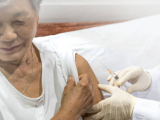Feb 1, 2007 (CIDRAP News) – The World Health Organization (WHO) said today that if the threat of an influenza pandemic increases, it will release viruses to vaccine manufacturers before completion of some safety tests, a step that could save about 2 weeks in vaccine development.
WHO collaborating centers, such as the US Centers for Disease Control and Prevention, have been developing recombinant viruses based on circulating strains of H5N1 avian influenza. If the WHO raises the pandemic alert level beyond the current stage of 3 (meaning a new virus is causing human cases, but there is no or very limited human-to-human transmission), those viruses will be released to vaccine manufacturers before safety tests on animals are completed, the agency said.
The WHO said it has been working with the World Organization for Animal Health (OIE) to determine how vaccine viruses can be released sooner than current practices dictate.
"Following an analysis of biosafety risks, WHO and OIE have agreed that if the pandemic preparedness alert phase reaches level 4 [signaling evidence of increased human-to-human transmission] or above, pandemic influenza vaccine viruses that have been developed using reverse genetics by WHO Collaborating Centres, can be made available to vaccine manufacturers prior to the completion of all subsequent in vivo safety tests, including chickens and ferrets," the WHO said.
"It is anticipated that this accelerated procedure will reduce the time required to develop pandemic vaccines by approximately 14 days," the statement said.
Health authorities generally estimate it will take at least 6 months from the time a pandemic strain emerges until the first doses of a precisely matched vaccine can be made available. The United States and other countries are currently stockpiling H5N1 vaccines, but no one knows how well they will work if existing H5N1 viruses evolve into a pandemic strain.
The accelerated procedure will be used only if the viruses involved are classified as an infectious substance as defined by the International Air Transport Association (IATA), the WHO said. In addition, the handling of such viruses must comply with all national import, export, and biosafety regulations as well as IATA regulations.
See also:
Dec 21, 2006, WHO statement on availability of recombinant H5N1 viruses for vaccine development

















